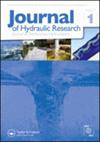研究了改进的双组分压力法在捕获大汽腔柱分离中的性能
IF 1.7
3区 工程技术
Q3 ENGINEERING, CIVIL
引用次数: 1
摘要
本文章由计算机程序翻译,如有差异,请以英文原文为准。
Investigating the performance of the modified two-component pressure approach in capturing column separation with large vapour cavities
This paper investigates the performance of the modified two-component pressure approach (proposed model), recently proposed by the authors, in capturing column separation with large vapour cavities. The proposed model calculates both the cavitating and waterhammer flow regions using a single set of equations that governs unsteady flow in open channels. Comparing the results with experimental data, and the results obtained from the discrete gas cavity model (counterpart model) reveals that: (1) the proposed model can accurately capture the evolution of large vapour cavities in pipe systems; (2) the model provides more accurate results compared to the counterpart model; (3) under some circumstances the counterpart provides inaccurate results as it fails to account for the energy loss in the cavitating flow zone while the proposed model was shown to resolve the issue. Finally, the results exhibit the superiority of the proposed model over the counterpart model and the conventional open-channel-based models.
求助全文
通过发布文献求助,成功后即可免费获取论文全文。
去求助
来源期刊

Journal of Hydraulic Research
工程技术-工程:土木
CiteScore
4.90
自引率
4.30%
发文量
55
审稿时长
6.6 months
期刊介绍:
The Journal of Hydraulic Research (JHR) is the flagship journal of the International Association for Hydro-Environment Engineering and Research (IAHR). It publishes research papers in theoretical, experimental and computational hydraulics and fluid mechanics, particularly relating to rivers, lakes, estuaries, coasts, constructed waterways, and some internal flows such as pipe flows. To reflect current tendencies in water research, outcomes of interdisciplinary hydro-environment studies with a strong fluid mechanical component are especially invited. Although the preference is given to the fundamental issues, the papers focusing on important unconventional or emerging applications of broad interest are also welcome.
 求助内容:
求助内容: 应助结果提醒方式:
应助结果提醒方式:


